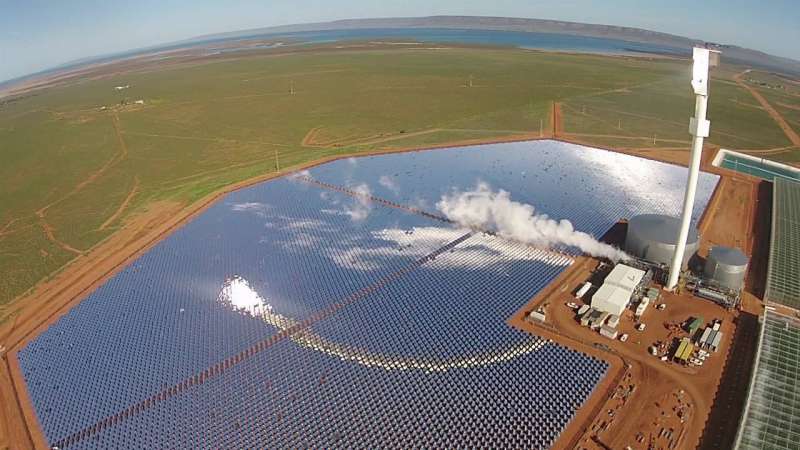October 11, 2016 weblog
Food future is now with Australia farm producing tomatoes on sea water and mirrors

(Tech Xplore)—And what may we ask is a state of the art tomato farm? Answering questions with questions may help. Can you grow tomatoes with just sea water and sunshine? An even more interesting question, can you deliver tons of tomatoes per year in the South Australian desert?
According to Farmers Weekly, the farm will produce 15,000t of tomatoes a year for the Australian domestic market.
MIT Technology Review similarly reported that the farm is expected "to produce more than 15,000 tons of the things per year when it reaches full capacity."
Those studying a new world order in agricultural systems have their eyes on Sundrop Farms. They have a technique that uses no soil, no pesticides (seawater cleans and sterilizes the air), no fossil fuels, no groundwater.
Yes, but can they really grow stuff? The answer is oh, yes. A video of Sundrop Farms in June this year, posted in July, shows images of greenhouses and a solar tower. A later video posted this month said Sundrop Farms is opening a commercial greenhouse in South Australia. It is already producing thousands of tons of tomatoes for a major retailer.
This is no mom-and-pop retirement adventure. Alice Klein in New Scientist said, a "team of scientists have spent the last six years fine-tuning the design – first with a pilot greenhouse built in 2010; then with a commercial-scale facility that began construction in 2014," and it has been officially launched.
Klein walked through the technical process. A desalination plant removes the salt. The plant is solar powered.
(Farmers Weekly said the desalination unit churns out 1m litres of fresh water a day.)
The fresh water irrigates tomato plants inside the greenhouse.
Seawater-soaked cardboard lines the greenhouse. This keeps the plants cool enough. Solar heating keeps the greenhouse warm enough in cold weather.
What drives solar power: 23,000 mirrors reflect sunlight towards a receiver tower, said Klein. "On a sunny day, up to 39 megawatts of energy can be produced – enough to power the desalination plant and supply the greenhouse's electricity needs."
This facility may be just the first. Sundrop is now planning to launch similar greenhouses in Portugal and the US, and another in Australia, said New Scientist.
"Now we are expanding," said the farm site. "What is already a success in Australia is coming soon to both the United States and Portugal. We've big plans for other markets too."
"It's not what we put in, it's what we leave out that matters," says a company motto. No soil, coconut husks instead. Water is taken from the sea or rain from roofs. And no pesticides; they said they prefer to introduce predatory insects to control harmful bugs in the greenhouse.
"We are showing the world that you can grow delicious, mouthwatering produce without needing fossil fuels, vast amounts of fresh water and thousands of acres of cultivated farmland."
Sundrop explained further what they do.
"A conventional greenhouse uses groundwater for irrigation, gas for heating, and electricity for cooling.
A Sundrop greenhouse turns seawater and sunlight into energy and water. We then use sustainably sourced carbon dioxide and nutrients to maximise the growth of our crops. Because we don't need soil, we're able to grow our produce on degraded land in arid areas previously considered too barren for agriculture."
There is good enough reason to follow their progress regarding what the future holds in food production. They said "by 2050 rising populations will see a 50% increase in food demand. Climate change is increasing the number and the severity of catastrophic weather events. And water scarcity is becoming more acute in arid regions. We need to look at alternative ways to create energy and to produce food."
More information: www.sundropfarms.com
© 2016 Tech Xplore
















